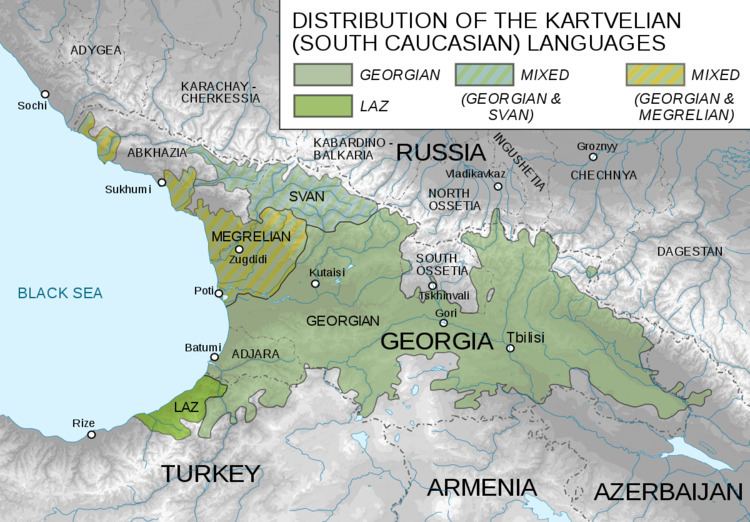Ethnicity Mingrelians | Native speakers (500,000 cited 1989) | |
 | ||
Language family KartvelianKarto-ZanZanMingrelian | ||
Mingrelian or Megrelian (მარგალური ნინა margaluri nina) is a Kartvelian language spoken in Western Georgia (regions of Samegrelo and Abkhazia), primarily by Mingrelians. The language was also called Iverian (Georgian iveriuli ena) in the early 20th century. Because for more than a thousand years Mingrelian has held only a regional status within Georgia, the number of its speakers has been decreasing in favor of the national language, with UNESCO designating it as a "definitely endangered language".
Contents
- Distribution and status
- History
- Vowels
- Consonants
- Vowel reduction
- Pre consonant change of velar g
- Positional change of uvular q sound
- Regressive assimilation of consonants
- Progressive dissimilation
- The transformation of l
- Intervocalic deletion of v
- Phonetic augmentation n
- Alphabet
- Dialects
- Famous speakers
- References
Distribution and status
No reliable figures exist for the number of Mingrelian native speakers, but it is estimated to be between 500,000 and 800,000. Most speakers live in the Samegrelo (Mingrelia) region of Georgia, that comprises the Odishi Hills and the Kolkheti Lowlands, from the Black Sea coast to the Svan Mountains and the Tskhenistskali River. Smaller enclaves existed in Abkhazia, but the ongoing civil unrest there has displaced many Mingrelian speakers to other regions of Georgia. Their geographical distribution is relatively compact, which has helped to promote the transmission of the language between generations.
Mingrelian is generally written with the Georgian alphabet, but has no written standard or official status. Almost all speakers are bilingual; they use Mingrelian mainly for familiar and informal conversation, and Georgian (or, for expatriate speakers, the local official language) for other purposes.
In the summer of 1999, books of the Georgian poet Murman Lebanidze were burned in the Mingrelian capital, Zugdidi, after he made disparaging remarks about the Mingrelian language.
History
Mingrelian is one of the Kartvelian languages. It is closely related to Laz, from which it has differentiated mostly in the last 500 years, after the northern (Mingrelian) and southern (Laz) communities were separated by Turkic invasions. It is somewhat less closely related to Georgian (the two branches having separated in the first millennium BC or earlier) and even more distantly related to Svan (which is believed to have branched off in the 2nd millennium BC or earlier). Mingrelian is not mutually intelligible with any of those other languages, although it is said that its speakers can recognize many Laz words.
Some linguists refer to Mingrelian and Laz as grouped within the Zan languages. Zan had already split into Mingrelian and Laz variants by early modern times, however, and it is not customary to speak of a unified Zan language today.
The oldest surviving texts in Mingrelian date from the 19th century, and are mainly ethnographical literature. The earliest linguistic studies of Mingrelian include a phonetic analysis by Aleksandre Tsagareli (1880), and grammars by Ioseb Kipshidze (1914) and Shalva Beridze (1920). From 1930 to 1938 several newspapers were published in Mingrelian, such as Kazakhishi Gazeti, Komuna, Samargalosh Chai, Narazenish Chai, and Samargalosh Tutumi. More recently, there has been some revival of the language, with the publication of dictionaries—Mingrelian–Georgian by Otar Kajaia, and Mingrelian-German by Otar Kajaia and Heinz Fähnrich—and poetry books by Lasha Gvakharia, Edem Izoria, Lasha Gvasalia, Guri Otobaia, Giorgi Sichinava, Jumber Kukava, and Vakhtang Kharchilava, as well as books and magazines published by Jehovah's Witnesses.
Vowels
Mingrelian has five primary vowels a, e, i, o, u. The Zugdidi-Samurzaqano dialect has a sixth, ə, which is the result of reduction of i and u.
Consonants
Consonant inventory of Mingrelian is almost identical to Laz, Georgian, and Svan.
Vowel reduction
Certain pairs of vowels reduce to single vowels:
In Zugdidi-Samurzaqano dialect the vowels i and u also often reduce to ə.
Pre-consonant change of velar g
Before consonants, g → r.
Positional change of uvular q' sound
In word-initial prevocalic and intervocalic positions, q' → ʔ. Before the consonant v, q' → ʔ/ḳ.
Regressive assimilation of consonants
The common types are:
Progressive dissimilation
If the stem contains r then the suffixes -ar and -ur transform to -al and -ul, e.g. xorga (Khorga, the village)→ xorg-ul-i ("Khorgan"). The rule is not valid if in the stem with r an l appears later, e.g. marṭvili ("Martvili", the town) → marṭvil-ur-i (adj. "Martvilian")
In a stem with voiceless affricates or voiceless sibilants, a later ǯ is deaffricated to d, e.g. orcxonǯi → orcxondi "comb", č'anǯi → č'andi "fly (insect)", isinǯi → isindi "arrow", etc.
The transformation of l
Intervocalic deletion of v
Between the vowels the organic v disappears, e.g. xvavi (Geo. "abundance, plenty") → *xvai → xvee (id.), mṭevani (Geo. "raceme") → ṭiani (id.), etc.
Phonetic augmentation n
Before the stops and affricates, an inorganic augmentation n may appear (before labials n → m).
Alphabet
Megrelian is written in the Mkhedruli script.
Dialects
The main dialects and subdialects of Mingrelian are:
